Abstract
The influence on pituitary function of 6 weeks of training on 6 days a week was examined in six recreational athletes. Endurance training on a bicycle ergometer for 31-33 min was performed on 4 days each week at 90-96% (weeks 1-3) and 89-92% (weeks 4-6) of the 4 mmol lactate thresholds determined on day 0 and day 21, respectively, with interval training of 3-5 x 3-5 min in addition on 2 days a week at 117-127% and 115-110%, respectively. Determination of the serum hormone levels and a combined pituitary function test (200 micrograms thyrotropin releasing hormone (TRH), 100 micrograms gonadotrophin-releasing hormone (GnRH), 100 micrograms corticotrophin releasing hormone (CRH), 50 micrograms growth hormone releasing hormone (GHRH)) were made before training, after 6 weeks of training and after another 3 weeks of recovery. Training increased performance at 2 mmol lactate by 25%, at 4 mmol by 12%, and maximum performance by approximately 12%. The releasing hormone-stimulable prolactin, thyroid stimulating hormone (TSH) and somatotrophic hormone (STH) synthesis-secretion capacity remained unchanged, the adrenocorticotrophic hormone (ACTH) was increased after training. Cortisol release was reduced, follicle-stimulating hormone (FSH)-synthesis-secretion capacity was increased after training, and the luteinizing hormone (LH)-synthesis-secretion capacity reduced. This had no influence on base or exercise-induced serum hormone levels (cortisol, aldosterone, insulin, prolactin, FSH, LH, TSH, ACTH, ADH and STH), which showed no dependence on training, except for free testosterone which showed a decreasing trend (P < 0.10) of 19-25% and post-exercise ACTH which showed an increasing trend of 33% (P < 0.10). Conditioning (cortisol sensitivity and ACTH response) or adaptation (FSH and LH responses) to changed testosterone serum levels and altered spermatogenesis is discussed.
Full text
PDF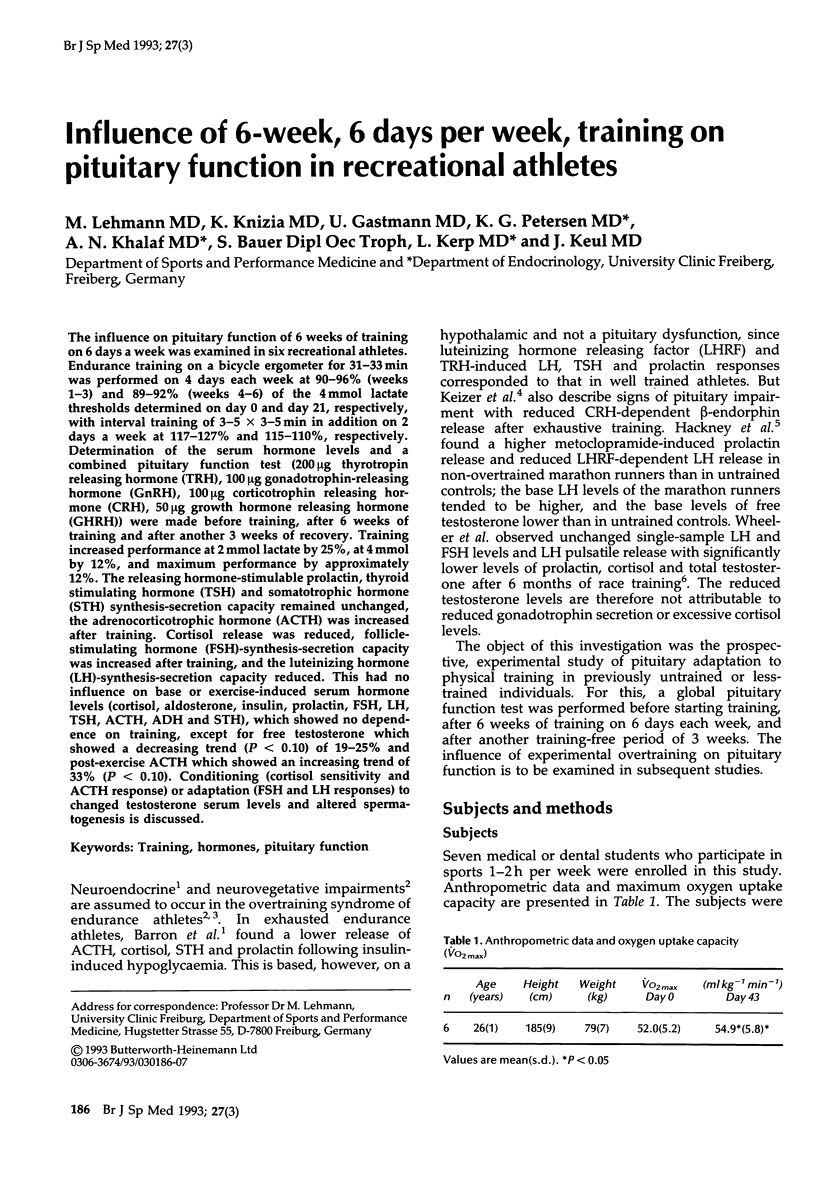
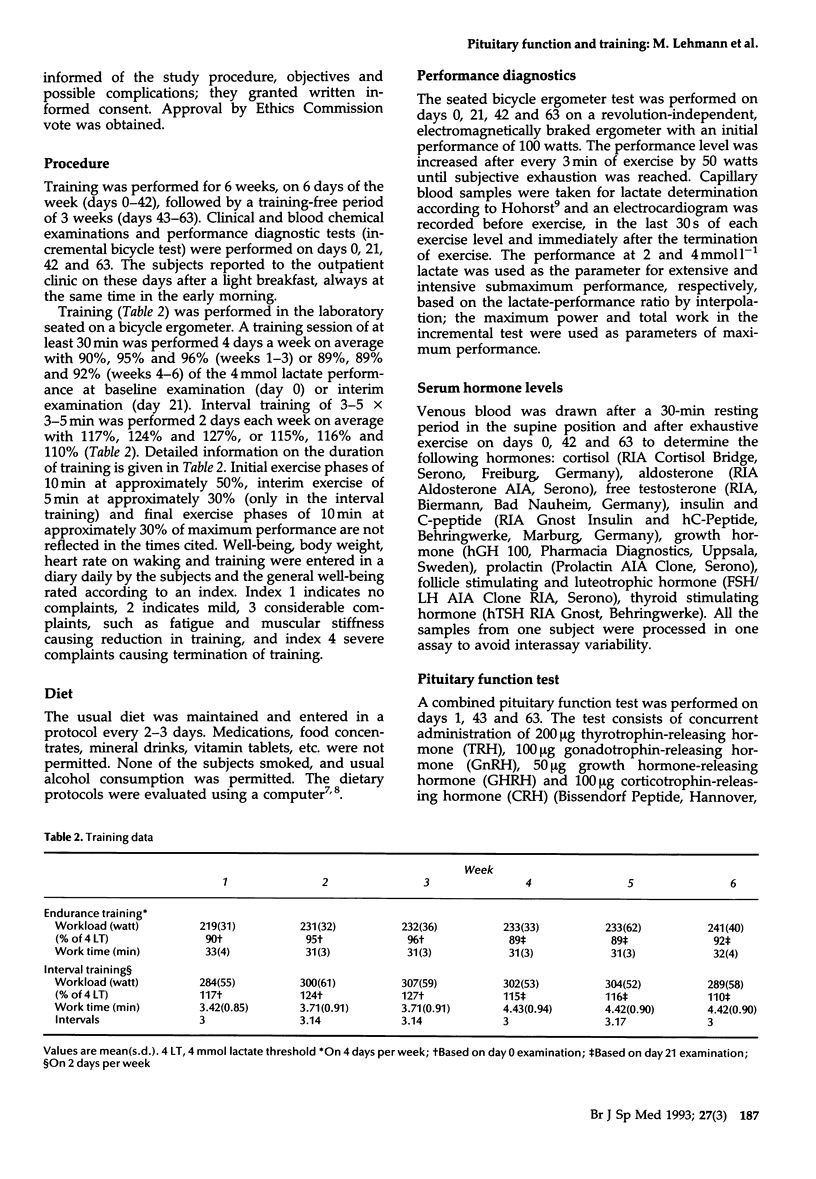
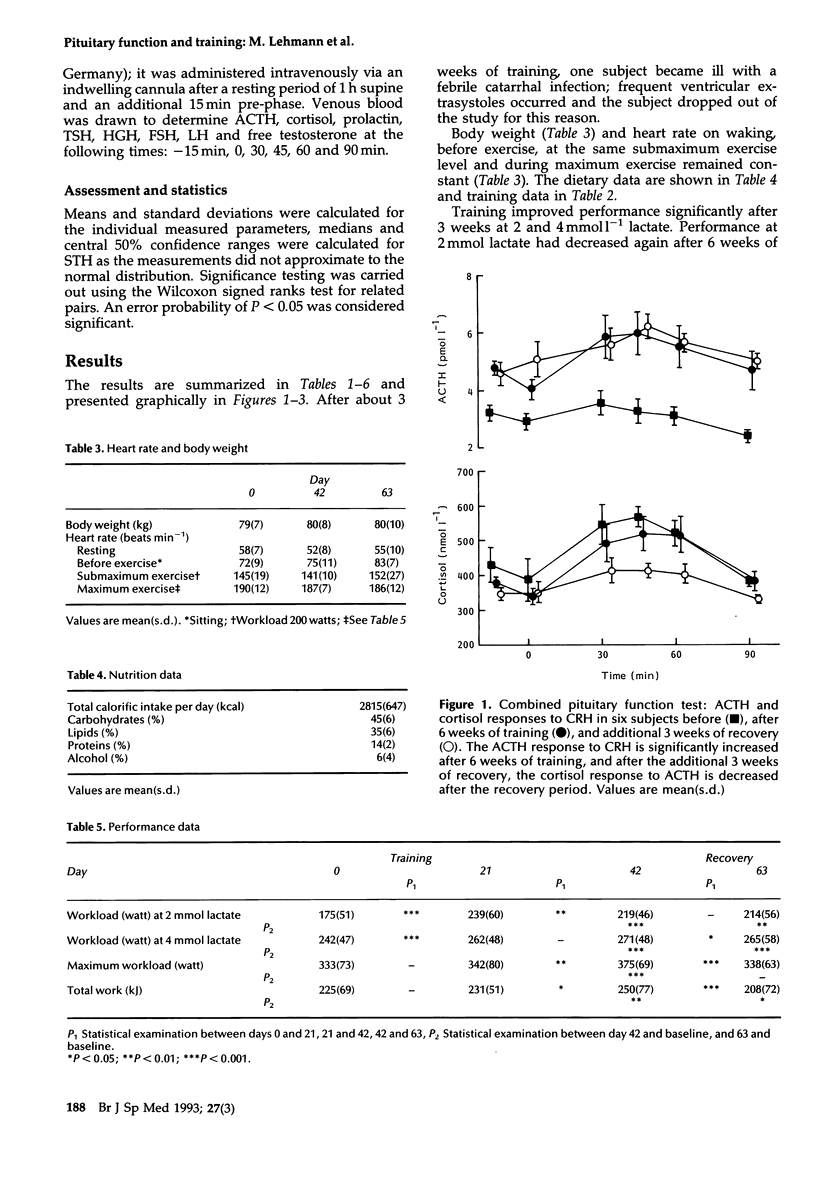
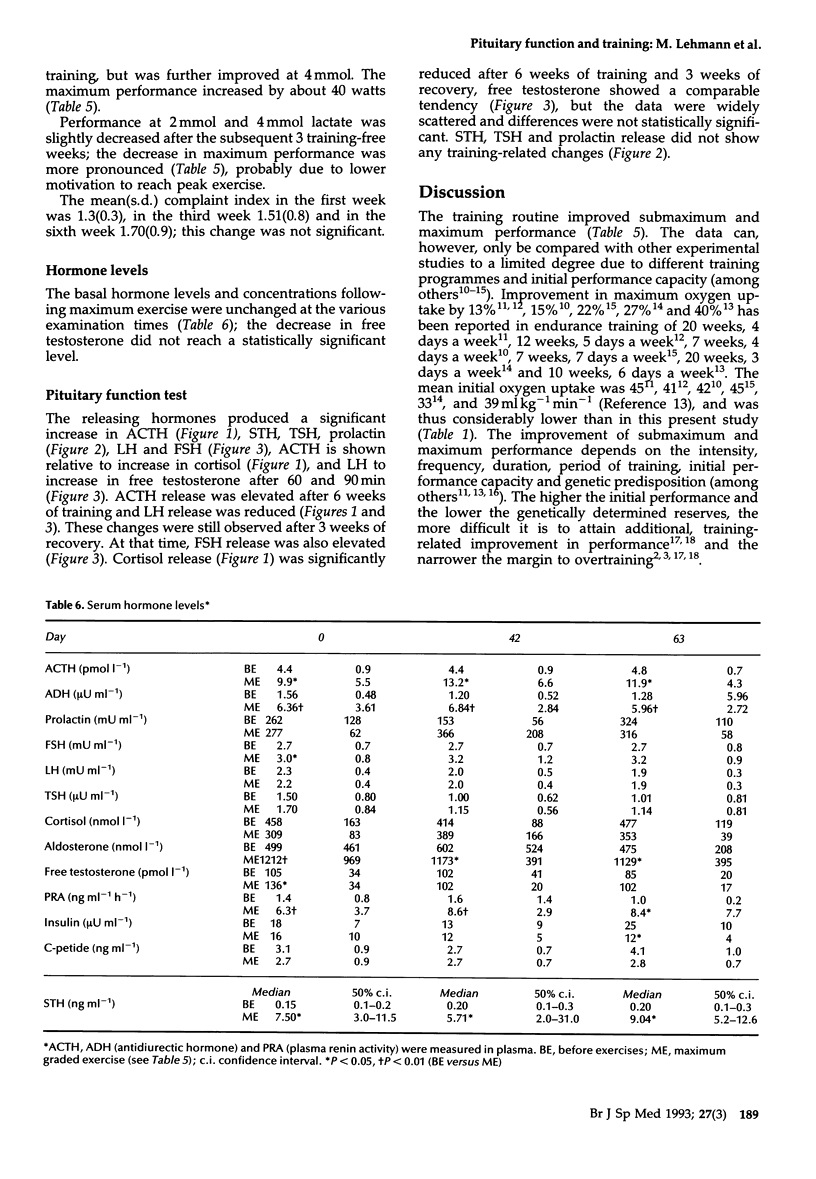
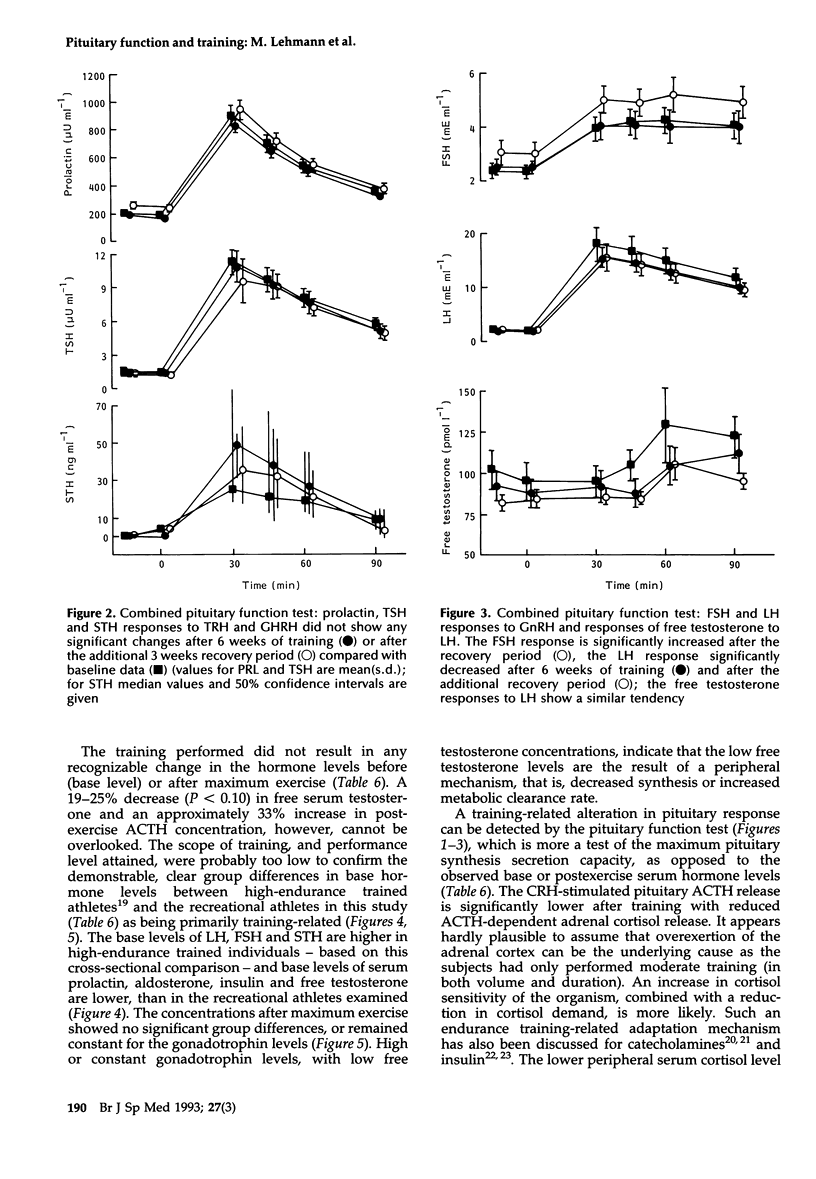
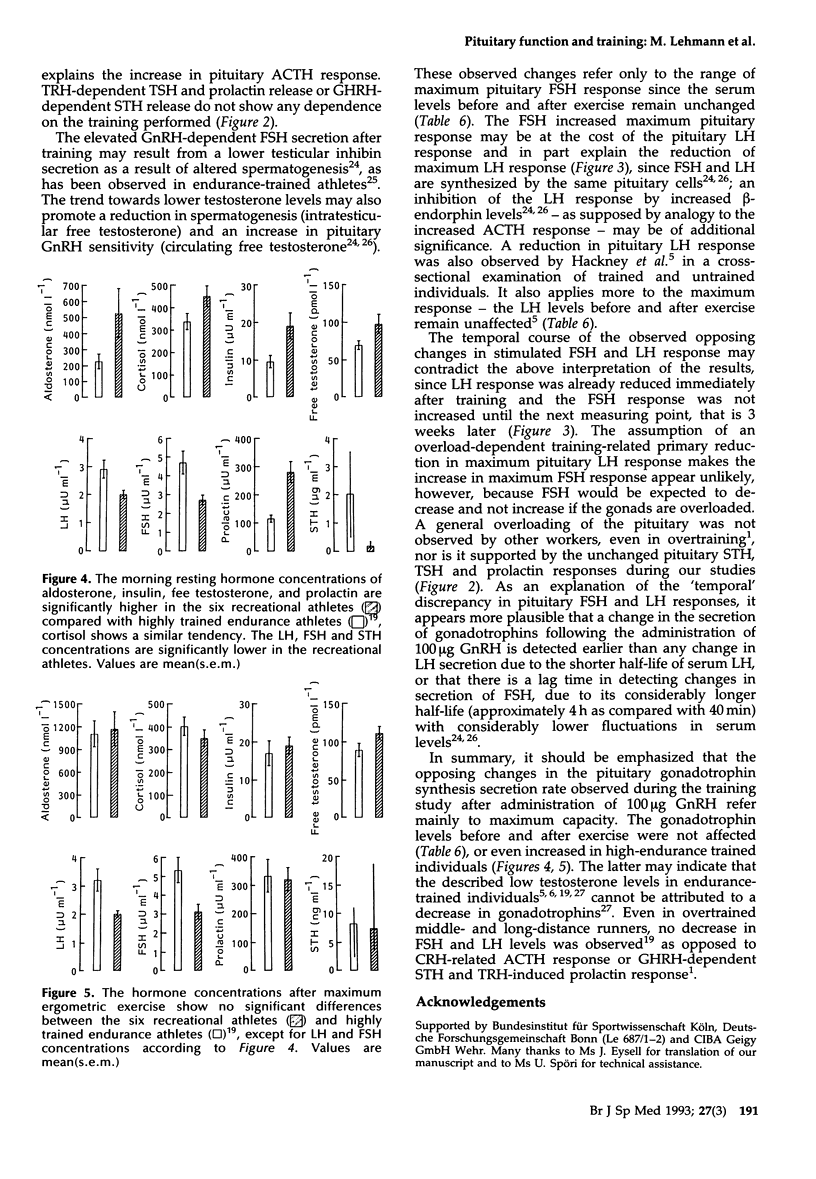
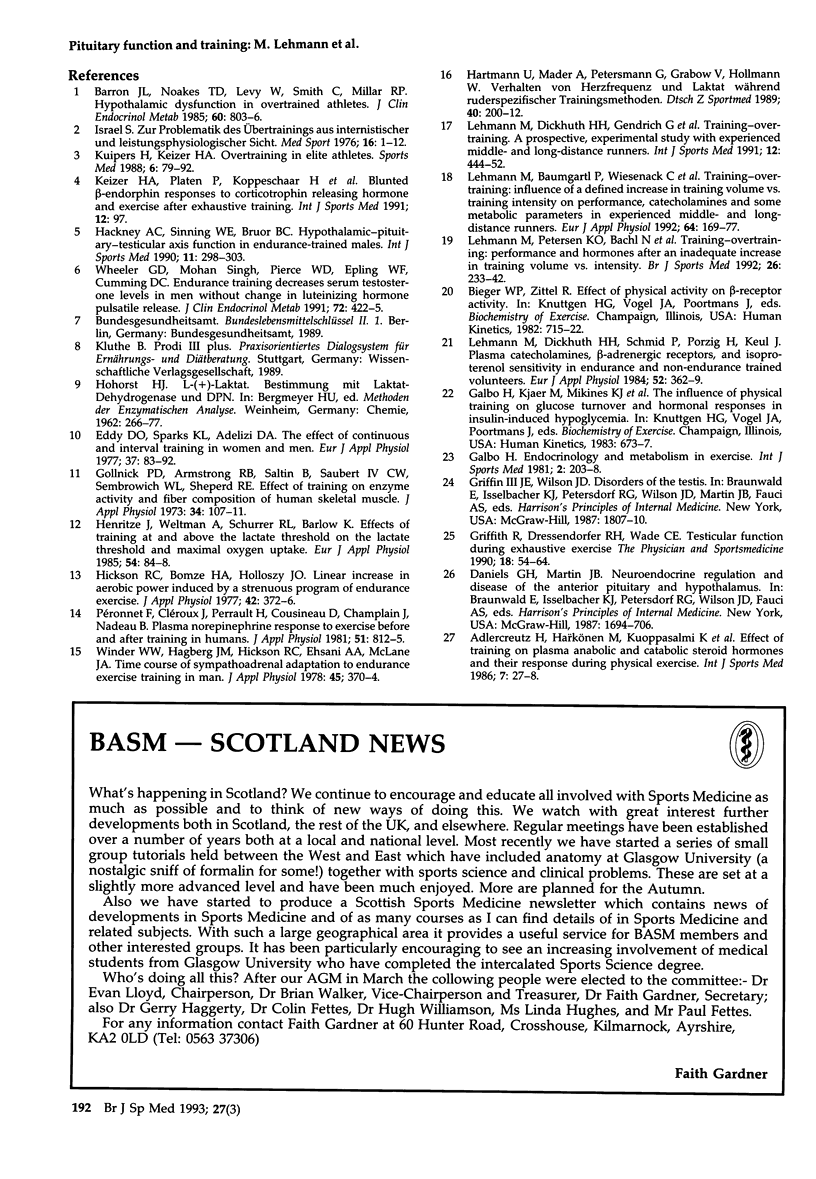
Selected References
These references are in PubMed. This may not be the complete list of references from this article.
- Adlercreutz H., Härkönen M., Kuoppasalmi K., Näveri H., Huhtaniemi I., Tikkanen H., Remes K., Dessypris A., Karvonen J. Effect of training on plasma anabolic and catabolic steroid hormones and their response during physical exercise. Int J Sports Med. 1986 Jun;7 (Suppl 1):27–28. doi: 10.1055/s-2008-1025798. [DOI] [PubMed] [Google Scholar]
- Barron J. L., Noakes T. D., Levy W., Smith C., Millar R. P. Hypothalamic dysfunction in overtrained athletes. J Clin Endocrinol Metab. 1985 Apr;60(4):803–806. doi: 10.1210/jcem-60-4-803. [DOI] [PubMed] [Google Scholar]
- Eddy D. O., Sparks K. L., Adelizi D. A. The effects of continuous and interval training in women and men. Eur J Appl Physiol Occup Physiol. 1977 Sep 16;37(2):83–92. doi: 10.1007/BF00421694. [DOI] [PubMed] [Google Scholar]
- Gollnick P. D., Armstrong R. B., Saltin B., Saubert C. W., 4th, Sembrowich W. L., Shepherd R. E. Effect of training on enzyme activity and fiber composition of human skeletal muscle. J Appl Physiol. 1973 Jan;34(1):107–111. doi: 10.1152/jappl.1973.34.1.107. [DOI] [PubMed] [Google Scholar]
- Hackney A. C., Sinning W. E., Bruot B. C. Hypothalamic-pituitary-testicular axis function in endurance-trained males. Int J Sports Med. 1990 Aug;11(4):298–303. doi: 10.1055/s-2007-1024811. [DOI] [PubMed] [Google Scholar]
- Henritze J., Weltman A., Schurrer R. L., Barlow K. Effects of training at and above the lactate threshold on the lactate threshold and maximal oxygen uptake. Eur J Appl Physiol Occup Physiol. 1985;54(1):84–88. doi: 10.1007/BF00426304. [DOI] [PubMed] [Google Scholar]
- Hickson R. C., Bomze H. A., Holloszy J. O. Linear increase in aerobic power induced by a strenuous program of endurance exercise. J Appl Physiol Respir Environ Exerc Physiol. 1977 Mar;42(3):372–376. doi: 10.1152/jappl.1977.42.3.372. [DOI] [PubMed] [Google Scholar]
- Kuipers H., Keizer H. A. Overtraining in elite athletes. Review and directions for the future. Sports Med. 1988 Aug;6(2):79–92. doi: 10.2165/00007256-198806020-00003. [DOI] [PubMed] [Google Scholar]
- Lehmann M., Baumgartl P., Wiesenack C., Seidel A., Baumann H., Fischer S., Spöri U., Gendrisch G., Kaminski R., Keul J. Training-overtraining: influence of a defined increase in training volume vs training intensity on performance, catecholamines and some metabolic parameters in experienced middle- and long-distance runners. Eur J Appl Physiol Occup Physiol. 1992;64(2):169–177. doi: 10.1007/BF00717956. [DOI] [PubMed] [Google Scholar]
- Lehmann M., Dickhuth H. H., Gendrisch G., Lazar W., Thum M., Kaminski R., Aramendi J. F., Peterke E., Wieland W., Keul J. Training-overtraining. A prospective, experimental study with experienced middle- and long-distance runners. Int J Sports Med. 1991 Oct;12(5):444–452. doi: 10.1055/s-2007-1024711. [DOI] [PubMed] [Google Scholar]
- Lehmann M., Dickhuth H. H., Schmid P., Porzig H., Keul J. Plasma catecholamines, beta-adrenergic receptors, and isoproterenol sensitivity in endurance trained and non-endurance trained volunteers. Eur J Appl Physiol Occup Physiol. 1984;52(4):362–369. doi: 10.1007/BF00943364. [DOI] [PubMed] [Google Scholar]
- Lehmann M., Gastmann U., Petersen K. G., Bachl N., Seidel A., Khalaf A. N., Fischer S., Keul J. Training-overtraining: performance, and hormone levels, after a defined increase in training volume versus intensity in experienced middle- and long-distance runners. Br J Sports Med. 1992 Dec;26(4):233–242. doi: 10.1136/bjsm.26.4.233. [DOI] [PMC free article] [PubMed] [Google Scholar]
- Péronnet F., Cléroux J., Perrault H., Cousineau D., de Champlain J., Nadeau R. Plasma norepinephrine response to exercise before and after training in humans. J Appl Physiol Respir Environ Exerc Physiol. 1981 Oct;51(4):812–815. doi: 10.1152/jappl.1981.51.4.812. [DOI] [PubMed] [Google Scholar]
- Wheeler G. D., Singh M., Pierce W. D., Epling W. F., Cumming D. C. Endurance training decreases serum testosterone levels in men without change in luteinizing hormone pulsatile release. J Clin Endocrinol Metab. 1991 Feb;72(2):422–425. doi: 10.1210/jcem-72-2-422. [DOI] [PubMed] [Google Scholar]
- Winder W. W., Hagberg J. M., Hickson R. C., Ehsani A. A., McLane J. A. Time course of sympathoadrenal adaptation to endurance exercise training in man. J Appl Physiol Respir Environ Exerc Physiol. 1978 Sep;45(3):370–374. doi: 10.1152/jappl.1978.45.3.370. [DOI] [PubMed] [Google Scholar]


